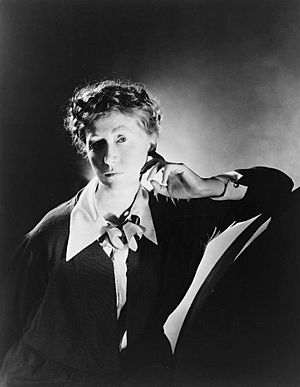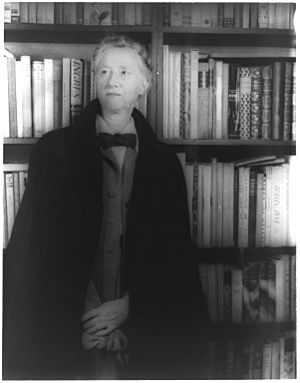Marianne Moore facts for kids
Quick facts for kids
Marianne Moore
|
|
|---|---|

Photograph by George Platt Lynes (1935)
|
|
| Born | November 15, 1887 Kirkwood, Missouri, U.S. |
| Died | February 5, 1972 (aged 84) New York City, U.S. |
| Occupation | Poet |
| Genre | Poetry |
| Literary movement | Modernism |
| Notable awards |
|
Marianne Craig Moore (born November 15, 1887 – died February 5, 1972) was a famous American modernist poet. She was also a critic, translator, and editor. Her poems are known for their unique style, clear words, and cleverness.
Contents
Growing Up and School
Marianne Moore was born in Kirkwood, Missouri, in 1887. Her grandfather was a pastor there. Her parents separated before she was born, and she never met her father. Marianne and her older brother, John, were raised by their mother, Mary.
Their family loved writing letters to each other. They often used fun nicknames from the book The Wind in the Willows. They even had their own secret language!
Marianne was very religious, like her mother and brother. She believed that faith helped people be strong through tough times. Her poems often talked about strength and facing challenges. She once said it was "not possible to live without religious faith."
Moore lived near St. Louis until she was six. After her grandfather died in 1894, her family lived with relatives near Pittsburgh for two years. Then they moved to Carlisle, Pennsylvania. There, her mother taught English at a private school for girls.
In 1905, Moore started college at Bryn Mawr College. She studied history, economics, and political science. She graduated four years later. While at Bryn Mawr, she began writing short stories and poems for the school's literary magazine. This is when she decided she wanted to be a writer. After college, she taught business subjects at the Carlisle Indian Industrial School from 1911 to 1914.
Becoming a Poet
Marianne Moore's first poems were published in magazines like The Egoist and Poetry in 1915. The editor of Poetry magazine, Harriet Monroe, said Moore's poems were "deeply musical."
In 1916, Moore and her mother moved to Chatham, New Jersey. This town was close enough to Manhattan for easy travel. Two years later, they moved to New York City's Greenwich Village. There, Moore met many new and exciting artists. Famous poets like Ezra Pound, William Carlos Williams, H.D., T. S. Eliot, and Wallace Stevens admired her poems.
Moore's first book, Poems, was published in 1921. It was put out by the poet H.D. and her friend Bryher, without Moore's permission. Moore's later poems were influenced by the Imagists, a group of poets who focused on clear images.
Her second book, Observations, won an award in 1924. Moore worked part-time as a librarian. Then, from 1925 to 1929, she edited The Dial magazine. This magazine was important for literature and culture. Her job helped her become a leader in the world of modern art and writing. She later encouraged young poets like Elizabeth Bishop and John Ashbery.
When The Dial stopped publishing in 1929, Moore moved to Fort Greene, Brooklyn. She lived there for 36 years. She kept writing while taking care of her mother, who passed away in 1947. For nine years, Moore worked on translating the Fables of La Fontaine.

In 1951, her book Collected Poems won three major awards: the National Book Award, the Pulitzer Prize, and the Bollingen Prize. T. S. Eliot wrote in the book's introduction that Moore's poems were "part of the small body of durable poetry written in our time."
After many years of living quietly, she became a celebrity. She gave talks at colleges and appeared in magazines like Life and Look. In 1967, she received the Edward MacDowell Medal for her great contributions to American culture. Moore continued to publish poems in various magazines, including The New Yorker.
In 1965, she moved back to Greenwich Village in Manhattan. People in town often recognized her by her unique tricorn hat and black cape. She loved sports and was a big fan of Muhammad Ali. She even wrote notes for his spoken-word album! She also loved baseball, first the Brooklyn Dodgers and then the New York Yankees. She even threw out the first pitch at Yankee Stadium in 1968.
At 81 years old, Moore received the 1968 National Medal for Literature. The award committee said she was "one of the few true inventors of poetry in our time."
Marianne Moore had several strokes in her last years. She passed away in 1972. Her ashes were buried with her mother's in Evergreen Cemetery in Gettysburg, Pennsylvania. By the time she died, she had received almost every honor an American poet could get. The New York Times printed a full-page article about her life. In 1996, she was honored by being added to the St. Louis Walk of Fame.
Moore wrote letters to Ezra Pound and visited him often when he was in the hospital. She was against Benito Mussolini and Fascism from the start. She also did not like Pound's anti-Jewish views. Moore was a Republican and supported Herbert Hoover in his presidential campaigns. She was a lifelong friend of the poet Wallace Stevens. She also wrote letters to the artist Joseph Cornell.
In 1955, the Ford company asked Moore to suggest names for a new car. They thought, "Who better to understand words than a poet?" Moore sent a list of names, including "Resilient Bullet" and "Utopian Turtletop." However, Ford ended up naming the car the Edsel.
Moore never married. Her living room has been kept exactly as it was at the Rosenbach Museum and Library in Philadelphia. You can see her whole library, small items (like a baseball signed by Mickey Mantle), all her letters, photos, and poem drafts there.
Moore often changed her early poems later in life. Many of these changed poems appeared in her Complete Poems in 1967. She once wrote, "Omissions are not accidents," meaning that she carefully chose what to leave out. In 1961, Moore said her favorite poem was the Book of Job from the Bible.
Moore's will set up a fund to help take care of the Camperdown Elm tree in Brooklyn's Prospect Park. This is a rare and old tree that she wrote about in a poem.
In 2012, she was added to the New York State Writers Hall of Fame.
Her Poetic Style
Moore's most famous poem is probably "Poetry". In this poem, she praises poets who create "imaginary gardens with real toads in them." She believed that how a poem sounds or looks on the page was less important than using language well and expressing true feelings. Moore often used a unique style called syllabic verse. This means she counted the number of syllables in each line, rather than focusing on rhymes or traditional rhythms.
She said that the poet Edith Sitwell helped her become more interested in rhythm. Moore liked rhymes that didn't always sound exactly the same. She felt the musical flow of the poem was more important than how the lines looked. She also thought of the whole stanza (a group of lines) as the main part of her poems, not just single lines.
In her poem "Poetry," she showed her idea that poetry is about skill and honesty. Even "business documents and school-books" can be important. But if a poem is written poorly, even with perfect form, it is not true poetry.
nor is it valid
to discriminate against "business documents and
school-books": all these phenomena are important. One must make a distinction
however: when dragged into prominence by half poets, the result is not poetry
Supporting Women's Rights
Marianne Moore was involved in the American movement for women's right to vote, called the suffrage movement. She started participating during her college years at Bryn Mawr, from 1905 to 1909. During this time, women in the state of Washington gained the right to vote.
Her college studies in history, politics, and economics, along with her professors' and classmates' involvement, introduced her to the movement. Moore was part of a "suffrage society" at Bryn Mawr. She attended many of their events. She wrote in her letters that she heard lectures by famous feminists like Jane Addams and Anne Cobden-Sanderson. She greatly admired the American suffragist Anna Howard Shaw.
In 1909, Moore visited New York City. She heard a lecture by a suffragist judge and went to a large meeting for women's voting rights. She also saw a play about women's suffrage. Some people believe Moore also marched in the women's suffrage parade in Washington, D.C., in 1913. She told her brother she wouldn't go because of possible dangers. However, her personal scrapbook has items about the march. She later told another poet that she "paraded with the suffragettes."
After 1913, Moore was not as public about her involvement. She started participating anonymously, often by writing under a different name. Years later, she admitted she "wrote suffrage pieces for the Carlisle newspaper." Scholars believe she wrote many pro-suffrage articles in the Carlisle Evening Herald in 1915. These articles often used her unique writing style, including many quotations. A letter supporting women's suffrage in another newspaper was signed "Miss M.M." Scholars think this was Marianne Moore.
Even though she was known as a modernist poet, Moore's writings often had a "sophisticated political subtext." This means her poems sometimes had hidden political messages.
Selected Works
- Poems, 1921
- Observations, 1924
- Selected Poems, 1935
- The Pangolin and Other Verse, 1936
- What Are Years, 1941
- Nevertheless, 1944
- A Face, 1949
- Collected Poems, 1951
- Fables of La Fontaine, 1954 (translations of La Fontaine's fables)
- Predilections: Literary Essays, 1955
- Like a Bulwark, 1956
- Idiosyncrasy and Technique, 1958
- O to Be a Dragon, 1959
- The Marianne Moore Reader, 1961
- Eight Poems, 1962
- The Absentee: A Comedy in Four Acts, 1962
- Puss in Boots, The Sleeping Beauty and Cinderella, 1963
- Dress and Kindred Subjects, 1965
- Poetry and Criticism, 1965
- Tell Me, Tell Me: Granite, Steel and Other Topics, 1966
- The Complete Poems of Marianne Moore, 1967
- The Accented Syllable, 1969
- Selected Poems, 1969
- Homage to Henry James, 1971
- The Complete Poems, 1982
- The Complete Prose, 1986
- Complete Poems, 1994
- The Selected Letters of Marianne Moore, 1997
- Becoming Marianne Moore: The Early Poems, 1907–1924, 2002
- Poems of Marianne Moore, 2003
Images for kids
See also
 In Spanish: Marianne Moore para niños
In Spanish: Marianne Moore para niños




